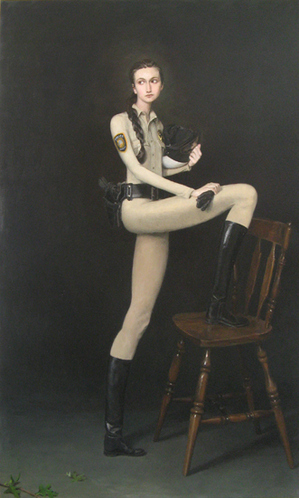This is an archive of the ArtCat Zine, 2007-2009. Please visit our new project, IDIOM.
Jansson Stegner at Bellwether
Jansson Stegner
15 November - 22 December, 2007
Bellwether Gallery - 134 Tenth Ave, New York NY
The way in which an artist chooses to depict their subject usually says as much about a subject as the subject itself. Jansson Stegner’s recent exhibition at Bellwether is indicative of this statement. Stegner’s subjects, police officers, are portrayed in a mannerist style, lounging in ideal naturalistic settings.
That mannerism is one of the first notable features of this work, and its historical pedigree lends his paintings their conceptual heft. The sixteenth century mannerist period dovetails nicely with the current state of the art world in the midst of high American imperialism — the printing press revolutionized media, commerce was expanding on a global scale, and the changing religious environment led to political and cultural strife. Art was changing too; the classical canon was abandoned, and artists began to stress intentional distortions. Arguably, we face a similar situation today in which the modernist canon has been abandoned for post-modern deconstructions.
Obviously Stegner is not the first to revisit this form; the figure of John Currin hangs over this exhibition with an uncanny sense of déjà vu. Both Currin and Stegner appropriate the formal devices of mannerism to point to the decadent state of art and culture. Whereas Currin makes a more ambiguous gesture towards the lifestyles of a carefree and privileged bourgeois, Stegner is much more politically explicit, choosing the police as his subject. His figures — like that of the young woman in Let Your Loveliness Fade As It Will, who stands contrapposto tying her long blond hair in a pony tail — are tender, seductive portraits of a vulnerable power.
In his last solo exhibition at Mike Weiss Gallery, Stegner portrayed his subjects, also dressed in police uniforms, in a variety of violent and taboo situations, such as a reckless motorcycle accident and a casual woodland orgy. His brushwork had a charming awkwardness, depicting just enough information to direct the viewer towards the broad outlines but leaving them to fill in the gruesome details. Those paintings had a sense of urgency, a personal involvement with a disordered and complex state in which his figures struggled.
This show leaves behind that expressive brushwork and personal touch, and moves towards a more aloof statement. Stegner’s brush no longer seems to battle with his characters, but historicizes them with a sense of psychological detachment. Throughout the show, Stegner maintains a singular format, his hot cops lounge idyllically, alone, their gaze averted and introspective. These figures betray their humanity and our self-recognition. Looking at these pictures might feel like looking at a display case in the Museum of Natural History: the animal has been stilled in a pose that only mimics the life it once had.
ZINE
HOME
TIPS / COMMENTS
CATEGORIES
CONTRIBUTORS
- Greg Afinogenov
- B. Blagojevic
- Adda Birnir
- Susannah Edelbaum
- Julie Fishkin
- Paddy Johnson
- Jessica Loudis
- Christopher Reiger
- Andrew Robinson
- Peter J. Russo
- Blythe Sheldon
- S.C.Squibb
- Hrag Vartanian

